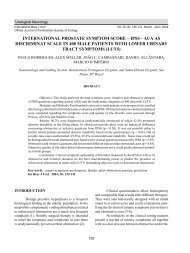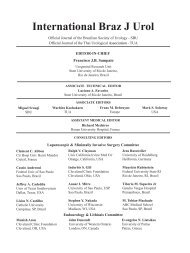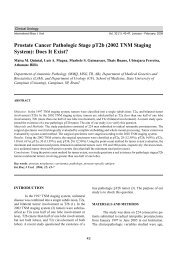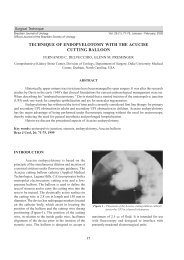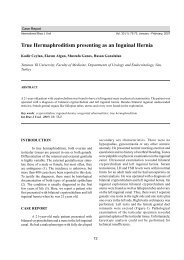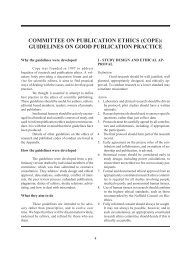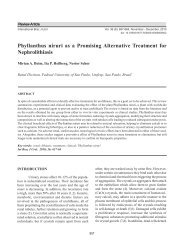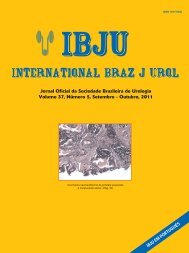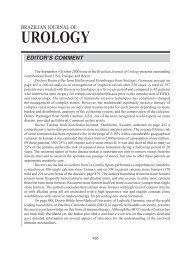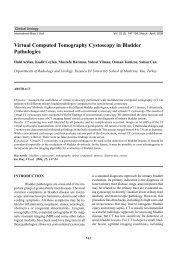Semen and Urine Culture in the Diagnosis of Chronic Bacterial ...
Semen and Urine Culture in the Diagnosis of Chronic Bacterial ...
Semen and Urine Culture in the Diagnosis of Chronic Bacterial ...
You also want an ePaper? Increase the reach of your titles
YUMPU automatically turns print PDFs into web optimized ePapers that Google loves.
Cl<strong>in</strong>ical Urology<br />
<strong>Chronic</strong> <strong>Bacterial</strong> Prostatitis<br />
International Braz J Urol Vol. 34(1): 30-40, January - February, 2008<br />
<strong>Semen</strong> <strong>and</strong> <strong>Ur<strong>in</strong>e</strong> <strong>Culture</strong> <strong>in</strong> <strong>the</strong> <strong>Diagnosis</strong> <strong>of</strong> <strong>Chronic</strong> <strong>Bacterial</strong><br />
Prostatitis<br />
L. R. Zegarra Montes, A. A. Sanchez Mejia, C. A. Loza Munarriz, E. Celis Gutierrez<br />
Department <strong>of</strong> Surgery, School <strong>of</strong> Medic<strong>in</strong>e Alberto Hurtado, Peruvian University Cayetano<br />
Heredia, Lima, Peru<br />
ABSTRACT<br />
Objective: To assess <strong>the</strong> diagnostic accuracy <strong>of</strong> semen <strong>and</strong> ur<strong>in</strong>e culture <strong>in</strong> <strong>the</strong> diagnosis <strong>of</strong> chronic bacterial prostatitis<br />
(CBP).<br />
Materials <strong>and</strong> Methods: In 70 consecutive men suspected <strong>of</strong> hav<strong>in</strong>g chronic bacterial prostatitis along with 17 asymptomatic<br />
controls, we obta<strong>in</strong>ed ur<strong>in</strong>e <strong>and</strong> semen cultures followed 1 week later by <strong>the</strong> Meares <strong>and</strong> Stamey test, our reference<br />
st<strong>and</strong>ard. The <strong>in</strong>terpretation <strong>of</strong> each <strong>of</strong> <strong>the</strong> cultures was bl<strong>in</strong>d to <strong>the</strong> results <strong>of</strong> o<strong>the</strong>r tests.<br />
Results: 139 men were referred for evaluation <strong>of</strong> chronic bacterial prostatitis <strong>and</strong> 70 received all tests. Additionally, 17 control<br />
men volunteered to participate. The Meares <strong>and</strong> Stamey Test was positive <strong>in</strong> 69 (79%) patients. The semen culture had a<br />
sensitivity <strong>of</strong> 45% <strong>and</strong> a specificity <strong>of</strong> 94%. The likelihood ratio associated with a positive semen culture was 8.1 (95%<br />
confidence <strong>in</strong>terval (CI) 1.2 to 55.3); <strong>the</strong> likelihood ratio associated with a negative semen culture was 0.6 (95% CI 0.5 to 0.7).<br />
The ur<strong>in</strong>e culture had a sensitivity <strong>of</strong> 4% <strong>and</strong> a specificity <strong>of</strong> 100%. The likelihood ratio <strong>of</strong> a positive ur<strong>in</strong>e culture was<br />
<strong>in</strong>f<strong>in</strong>ity <strong>and</strong> <strong>of</strong> a negative ur<strong>in</strong>e culture was 0.96 (95% CI 0.9 to 1).<br />
Conclusions: While a positive semen culture <strong>in</strong> a symptomatic patient may suffice to select <strong>and</strong> start antibiotic treatment<br />
aga<strong>in</strong>st chronic bacterial prostatitis, a negative culture does not rule out <strong>the</strong> condition. <strong>Ur<strong>in</strong>e</strong> cultures alone are not useful<br />
for diagnos<strong>in</strong>g CBP. The Meares <strong>and</strong> Stamey test rema<strong>in</strong>s important for <strong>the</strong> diagnosis <strong>of</strong> CBP <strong>in</strong> practice.<br />
Key words: ur<strong>in</strong>ary tract <strong>in</strong>fections; prostate; prostatitis; diagnosis; laboratory techniques <strong>and</strong> procedures<br />
Int Braz J Urol. 2008; 34: 30-40<br />
INTRODUCTION<br />
<strong>Chronic</strong> prostatitis (CP) is a very common<br />
urologic diagnosis <strong>in</strong> men (1, 2), with 50% <strong>of</strong> men<br />
hav<strong>in</strong>g this condition at some po<strong>in</strong>t <strong>in</strong> <strong>the</strong>ir life (3).<br />
Men with chronic prostatitis experience a similar loss<br />
<strong>in</strong> quality <strong>of</strong> life that survivors <strong>of</strong> recent acute coronary<br />
syndromes do (4).<br />
<strong>Chronic</strong> bacterial prostatitis (CBP) or chronic<br />
prostatitis category II (5) is def<strong>in</strong>ed <strong>in</strong> men with<br />
documented recurrent ur<strong>in</strong>ary tract <strong>in</strong>fections (UTI)<br />
who may be asymptomatic between episodes, or may<br />
present chronic genitour<strong>in</strong>ary pa<strong>in</strong> for more than 3<br />
months <strong>in</strong> association with bacterial isolation from <strong>the</strong><br />
prostate (6-8). About 10% <strong>of</strong> cases <strong>of</strong> CP have a<br />
bacterial etiology. Escherichia coli accounts for up to<br />
80% <strong>of</strong> cases <strong>of</strong> (CBP) (6).<br />
In 1968, Meares <strong>and</strong> Stamey described <strong>the</strong><br />
four-glass test, which cont<strong>in</strong>ues to be <strong>the</strong> reference<br />
st<strong>and</strong>ard test for CBP. This test localizes <strong>the</strong><br />
<strong>in</strong>flammatory <strong>and</strong> bacteriologic focus along <strong>the</strong> lower<br />
ur<strong>in</strong>ary tract <strong>and</strong> prostate (9). The cost, <strong>in</strong>convenience<br />
30
<strong>Chronic</strong> <strong>Bacterial</strong> Prostatitis<br />
<strong>and</strong> discomfort to patients, however, decrease its<br />
feasibility <strong>in</strong> practice: a survey <strong>of</strong> U.S. urologists found<br />
that 80% hardly ever used <strong>the</strong> Meares <strong>and</strong> Stamey<br />
test to diagnose CBP (10). Simpler tests <strong>in</strong>clud<strong>in</strong>g<br />
modifications <strong>of</strong> <strong>the</strong> orig<strong>in</strong>al technique such as <strong>the</strong> pre<br />
<strong>and</strong> post massage test (11), expressed prostatic<br />
secretion culture, semen culture, <strong>and</strong> ur<strong>in</strong>e culture,<br />
while more feasible, convenient, or <strong>in</strong>expensive, seem<br />
unsatisfactory alternatives. The reported sensitivity <strong>of</strong><br />
semen culture to <strong>the</strong> diagnosis <strong>of</strong> CBP varies between<br />
10 <strong>and</strong> 100% (12 - 14), <strong>and</strong> that <strong>of</strong> ur<strong>in</strong>e culture is<br />
10% (13).<br />
In our urology referral service, we have<br />
noticed that patients referred with <strong>the</strong> tentative<br />
diagnosis <strong>of</strong> chronic bacterial prostatitis that were<br />
ultimately found to have a positive Meares <strong>and</strong> Stamey<br />
test had a prior negative semen <strong>and</strong> ur<strong>in</strong>e culture.<br />
Therefore, we sought to determ<strong>in</strong>e <strong>the</strong> diagnostic<br />
accuracy <strong>of</strong> <strong>the</strong> semen <strong>and</strong> ur<strong>in</strong>e cultures compared<br />
to <strong>the</strong> Meares <strong>and</strong> Stamey test <strong>in</strong> <strong>the</strong> diagnosis <strong>of</strong><br />
CBP.<br />
MATERIALS AND METHODS<br />
This is a prospective test performance study.<br />
The <strong>in</strong>stitutional ethics committee approved <strong>the</strong><br />
protocol <strong>and</strong> consent procedures used <strong>in</strong> this study.<br />
We enrolled consecutively 70 adult men<br />
attend<strong>in</strong>g <strong>the</strong> Urology <strong>and</strong> Oncology Service <strong>of</strong><br />
Cayetano Heredia National Hospital, <strong>in</strong> Lima, Peru<br />
from September 2003 to October 2004 who had cl<strong>in</strong>ical<br />
suspicion <strong>of</strong> CBP on <strong>the</strong> basis <strong>of</strong> recurrent episodes<br />
<strong>of</strong> UTI <strong>and</strong>/or symptoms <strong>of</strong> chronic genitour<strong>in</strong>ary pa<strong>in</strong><br />
with<strong>in</strong> <strong>the</strong> last 3 months localized <strong>in</strong> <strong>the</strong> per<strong>in</strong>eum,<br />
suprapubic area, penis, testes, gro<strong>in</strong>, low back, or pa<strong>in</strong><br />
dur<strong>in</strong>g or after ejaculation. Patients gave written<br />
<strong>in</strong>formed consent to participate <strong>in</strong> this study.<br />
In order to asses <strong>the</strong> discrim<strong>in</strong>atory capacity<br />
<strong>of</strong> <strong>the</strong> semen <strong>and</strong> ur<strong>in</strong>e cultures, we additionally<br />
enrolled 17 asymptomatic adult men who volunteered<br />
to participate <strong>in</strong> this study <strong>and</strong> who did not have any<br />
history <strong>of</strong> previous UTI or chronic genitour<strong>in</strong>ary pa<strong>in</strong>.<br />
Ineligible patients showed evidence <strong>of</strong> o<strong>the</strong>r<br />
<strong>in</strong>fections received antibiotic treatment with<strong>in</strong> <strong>the</strong><br />
month prior to <strong>the</strong> study, used ur<strong>in</strong>ary ca<strong>the</strong>ters or<br />
o<strong>the</strong>r urological devices, had undergone prostatectomy,<br />
or had prostate cancer. After a complete physical <strong>and</strong><br />
urological exam<strong>in</strong>ation, <strong>the</strong> participants completed <strong>the</strong><br />
National Institutes <strong>of</strong> Health <strong>Chronic</strong> Prostatitis<br />
Symptom Index (NIH-CPSI) (15, 16).<br />
In order to evaluate <strong>the</strong> diagnostic<br />
performance <strong>of</strong> semen <strong>and</strong> ur<strong>in</strong>e cultures, we<br />
developed an Alternative test based on <strong>the</strong> Meares<br />
<strong>and</strong> Stamey test. Table 1 describes how <strong>the</strong> samples<br />
were collected for our alternative test.<br />
The samples were exam<strong>in</strong>ed directly <strong>and</strong><br />
cultured. For <strong>the</strong> Alternative test, we considered <strong>the</strong><br />
test positive when: 1) <strong>the</strong>re were bacteria <strong>in</strong> <strong>the</strong> semen<br />
sample; <strong>and</strong> 2a) no bacteria was found <strong>in</strong> <strong>the</strong> VB1 <strong>and</strong><br />
VB2 samples or 2b) <strong>the</strong> bacterial colony count <strong>in</strong> <strong>the</strong><br />
semen sample was ≥ 10 times that <strong>in</strong> <strong>the</strong> VB1 <strong>and</strong><br />
VB2 specimens. The VB3 sample was not considered<br />
<strong>in</strong> <strong>the</strong> analysis <strong>of</strong> <strong>the</strong> results <strong>of</strong> <strong>the</strong> semen culture. VB2<br />
cultures were <strong>the</strong> ur<strong>in</strong>e cultures for this study. Positive<br />
ur<strong>in</strong>e cultures had colony counts ≥ 10 5 UFC/mL.<br />
The Meares <strong>and</strong> Stamey test was taken as<br />
our st<strong>and</strong>ard. It was performed accord<strong>in</strong>g to <strong>the</strong><br />
st<strong>and</strong>ard procedure (Table-1) (9) <strong>and</strong> one week after<br />
<strong>the</strong> Alternative test to avoid contam<strong>in</strong>ation <strong>of</strong> <strong>the</strong> semen<br />
sample by <strong>the</strong> prostatic secretion. None <strong>of</strong> <strong>the</strong> patients<br />
received any antibiotic <strong>the</strong>rapy dur<strong>in</strong>g this week. For<br />
<strong>the</strong> Meares <strong>and</strong> Stamey test, we considered <strong>the</strong> test<br />
positive if <strong>the</strong>re was a 10-fold <strong>in</strong>crease <strong>in</strong> bacteria <strong>in</strong><br />
<strong>the</strong> expressed prostatic secretion (EPS) or <strong>in</strong> VB3<br />
samples compared with <strong>the</strong> VB1 <strong>and</strong> VB2 specimens.<br />
All <strong>the</strong> samples <strong>of</strong> this study were centrifuged<br />
<strong>and</strong> seeded on blood agar <strong>and</strong> McConkey media with<br />
st<strong>and</strong>ard biochemical tests to characterize bacteria.<br />
Additionally, <strong>the</strong> presence <strong>of</strong> over 10 leukocytes per<br />
high-power field (X40) <strong>in</strong> <strong>the</strong> expressed prostatic<br />
secretion sample <strong>in</strong>dicated prostatitis (17, 18).<br />
All <strong>the</strong> process<strong>in</strong>g <strong>and</strong> read<strong>in</strong>g <strong>of</strong> <strong>the</strong> samples<br />
<strong>of</strong> this study were performed by <strong>the</strong> same expert<br />
microbiologist who was bl<strong>in</strong>ded to <strong>the</strong> patient’s history<br />
<strong>and</strong> results <strong>of</strong> previous tests. Samples from <strong>the</strong><br />
Alternative test received a different codification from<br />
those <strong>of</strong> <strong>the</strong> Meares <strong>and</strong> Stamey test <strong>in</strong> order to<br />
guarantee <strong>the</strong> <strong>in</strong>dependent <strong>in</strong>terpretation <strong>of</strong> <strong>the</strong> results.<br />
F<strong>in</strong>ally, we def<strong>in</strong>ed CBP as <strong>the</strong> presence <strong>of</strong><br />
1) a positive result <strong>in</strong> <strong>the</strong> Meares <strong>and</strong> Stamey test<br />
<strong>and</strong> 2a) <strong>the</strong> presence <strong>of</strong> recurrent episodes <strong>of</strong> UTI<br />
31
<strong>Chronic</strong> <strong>Bacterial</strong> Prostatitis<br />
Table 1 – Procedures for obta<strong>in</strong><strong>in</strong>g <strong>the</strong> samples for our Alternative Test <strong>and</strong> <strong>the</strong> Meares <strong>and</strong> Stamey reference test.<br />
Alternative Test<br />
1. Urethral ur<strong>in</strong>e - <strong>the</strong> first 10 cc ur<strong>in</strong>e (voided bladder 1<br />
or VB1)<br />
2. Mid-stream ur<strong>in</strong>e – 10 cc <strong>of</strong> ur<strong>in</strong>e after <strong>the</strong> man voids<br />
150 cc (voided bladder 2 or VB2)<br />
3. <strong>Semen</strong> sample obta<strong>in</strong>ed by masturbation<br />
4. Post-ejaculation ur<strong>in</strong>e – collected immediately after<br />
ejaculation (voided bladder 3 or VB3)<br />
Meares <strong>and</strong> Stamey Test<br />
1. Urethral ur<strong>in</strong>e - <strong>the</strong> first 10 cc ur<strong>in</strong>e (voided bladder 1<br />
or VB1)<br />
2. Mid-stream ur<strong>in</strong>e - 10 cc <strong>of</strong> ur<strong>in</strong>e after <strong>the</strong> man voids<br />
150 cc (voided bladder 2 or VB2)<br />
3. Expressed prostatic secretion sample post prostatic<br />
massage<br />
4. <strong>Ur<strong>in</strong>e</strong> post prostatic massage - 10 cc ur<strong>in</strong>e post<br />
massage (voided bladder 3 or VB3)<br />
or 2b) symptoms <strong>of</strong> already described chronic<br />
genitour<strong>in</strong>ary pa<strong>in</strong>.<br />
Statistical data were ga<strong>the</strong>red <strong>in</strong>to a Micros<strong>of</strong>t<br />
Excel XP database <strong>and</strong> transferred to <strong>the</strong> version<br />
9STATA s<strong>of</strong>tware. We use descriptive statistics to<br />
characterize <strong>the</strong> study population, <strong>and</strong> we compare<br />
<strong>the</strong> characteristics <strong>of</strong> those with <strong>and</strong> without<br />
documented chronic bacterial prostatitis us<strong>in</strong>g ei<strong>the</strong>r<br />
<strong>the</strong> chi square test (for proportions) or <strong>the</strong> <strong>in</strong>dependent<br />
sample t-test (for cont<strong>in</strong>uous variables). We also<br />
estimated <strong>the</strong> sensitivity <strong>and</strong> specificity <strong>of</strong> each test<br />
(<strong>and</strong> <strong>the</strong>ir correspond<strong>in</strong>g 95% confidence <strong>in</strong>tervals)<br />
compared with <strong>the</strong> reference st<strong>and</strong>ard, <strong>and</strong> calculated<br />
<strong>the</strong> likelihood ratios associated with a positive <strong>and</strong> a<br />
negative semen culture. The likelihood ratio <strong>of</strong> a test<br />
result is <strong>the</strong> ratio <strong>of</strong> <strong>the</strong> proportion <strong>of</strong> patients with<br />
CBP who had <strong>the</strong> test result to <strong>the</strong> proportion <strong>of</strong><br />
patients without CBP who had <strong>the</strong> same result (19).<br />
We used likelihood ratios because <strong>of</strong> <strong>the</strong>ir<br />
advantages <strong>in</strong> <strong>the</strong> assessment <strong>of</strong> diagnostic tests, i.e.,<br />
<strong>the</strong>y are less likely to change with <strong>the</strong> prevalence <strong>of</strong><br />
<strong>the</strong> disease, <strong>the</strong>y can be calculated for several levels<br />
<strong>of</strong> symptoms, signs or tests, <strong>and</strong> <strong>the</strong>y can be used to<br />
calculate post-test probability for a target disorder (20).<br />
RESULTS<br />
We assessed 139 consecutive men referred<br />
for symptoms consistent with chronic prostatitis, but<br />
only 70 <strong>of</strong> <strong>the</strong>m completed all <strong>the</strong> tests <strong>and</strong> were<br />
considered <strong>in</strong> <strong>the</strong> study. We additionally enrolled 17<br />
asymptomatic patients that volunteered to participate.<br />
The mean age <strong>of</strong> <strong>the</strong> population was 37.5 years (±<br />
9.7). Table-2 describes <strong>the</strong> population by <strong>the</strong>ir cl<strong>in</strong>ical<br />
presentation. The means <strong>and</strong> st<strong>and</strong>ard deviations <strong>of</strong><br />
<strong>the</strong> NIH-CPSI scores are also shown.<br />
The Meares <strong>and</strong> Stamey test was positive<br />
<strong>in</strong> 69 patients. Forty-four had gram-negative bacteria,<br />
<strong>and</strong> 25 had gram-positive bacteria. The isolated<br />
bacteria were Escherichia coli <strong>in</strong> 32, Enterococcus<br />
sp. <strong>in</strong> 13, Staphylococcus aureus <strong>in</strong> 10, Klebsiella<br />
sp. <strong>in</strong> 7, Enterobacter sp. 4, Streptococcus Group D<br />
<strong>in</strong> 1, coagulase-negative Staphylococcus <strong>in</strong> 1 <strong>and</strong><br />
Proteus vulgaris <strong>in</strong> 1. The results <strong>of</strong> <strong>the</strong> gold st<strong>and</strong>ard<br />
<strong>and</strong> semen cultures <strong>in</strong> <strong>the</strong> symptomatic <strong>and</strong><br />
asymptomatic patients are shown <strong>in</strong> Table-3. There<br />
was co<strong>in</strong>cidence <strong>in</strong> <strong>the</strong> bacteria isolated <strong>in</strong> <strong>the</strong><br />
Alternative test <strong>and</strong> <strong>the</strong>ir correspond<strong>in</strong>g isolates <strong>in</strong><br />
<strong>the</strong> reference st<strong>and</strong>ard, except for one patient who<br />
presented S. aureus <strong>in</strong> <strong>the</strong> semen culture <strong>and</strong> E. coli<br />
<strong>in</strong> <strong>the</strong> Meares <strong>and</strong> Stamey test. Although we<br />
performed a VB3 sample as part <strong>of</strong> our Alternative<br />
test, we did not consider it <strong>in</strong> <strong>the</strong> analysis <strong>of</strong> <strong>the</strong> semen<br />
cultures. It was found positive only <strong>in</strong> 9 <strong>of</strong> <strong>the</strong> 32<br />
patients with positive semen cultures, with a<br />
bacteriologic correlation <strong>of</strong> 100%.<br />
Table-4 describes <strong>the</strong> performance <strong>of</strong> <strong>the</strong><br />
semen culture <strong>in</strong> comparison to <strong>the</strong> reference st<strong>and</strong>ard.<br />
It shows a semen culture sensitivity <strong>of</strong> 45% (95% CI<br />
32
<strong>Chronic</strong> <strong>Bacterial</strong> Prostatitis<br />
Table 2 – Cl<strong>in</strong>ical <strong>and</strong> demographic differences among symptomatic <strong>and</strong> asymptomatic patients.<br />
Age <strong>in</strong> years (SD)<br />
Symptomatic Patients<br />
N = 70<br />
36.6<br />
Asymptomatic Patients<br />
N = 17<br />
41.1<br />
p Value<br />
= 0.08<br />
More than one sexual partner<br />
Background <strong>of</strong> UTI<br />
Partner with leucorrhea<br />
Total NIH-CPSI score(SD)<br />
N %<br />
08 11.59<br />
61 87.1<br />
20 28.6<br />
19.9 (7.97)<br />
N %<br />
2 11.6<br />
0 =0<br />
8 47<br />
6.8 (5.6)<br />
p Value<br />
= 0.98<br />
< 0.001<br />
= 0.15<br />
< 0.001<br />
Physical exam<br />
Abdom<strong>in</strong>al pa<strong>in</strong><br />
Pa<strong>in</strong> <strong>in</strong> <strong>the</strong> penis<br />
Right testis pa<strong>in</strong><br />
Left testis pa<strong>in</strong><br />
Pa<strong>in</strong> <strong>in</strong> <strong>the</strong> prostate<br />
N %<br />
11 15.7<br />
09 12.9<br />
04 05.7<br />
09 12.9<br />
08 11.4<br />
N %<br />
0 00<br />
0 00<br />
3 17.6<br />
2 12<br />
3 17.6<br />
p Value<br />
0=0.08<br />
0=0.12<br />
0=0.1<br />
0=0.1<br />
0=0.5<br />
SD = st<strong>and</strong>ard deviation, UTI = ur<strong>in</strong>ary tract <strong>in</strong>fections, NIH-CPSI = National Institute <strong>of</strong> Health – <strong>Chronic</strong> Prostatitis Symptom Index.<br />
33.8% to 56.6%), specificity <strong>of</strong> 94% (95% CI 74.2%<br />
to 99%), a likelihood ratio associated with a positive<br />
semen culture <strong>of</strong> 8.1 (95% CI 1.2 to 55.3), <strong>and</strong><br />
likelihood ratio associated with a negative semen<br />
culture <strong>of</strong> 0.6 (95% CI 0.5 to 0.7).<br />
Figures-1 <strong>and</strong> 2 show how <strong>the</strong> post-test<br />
probability <strong>of</strong> hav<strong>in</strong>g CBP varies compared to <strong>the</strong><br />
different pre-test probabilities (cl<strong>in</strong>ical suspicion)<br />
accord<strong>in</strong>g to <strong>the</strong> likelihood ratios.<br />
The performance <strong>of</strong> <strong>the</strong> ur<strong>in</strong>e culture <strong>in</strong><br />
relation to <strong>the</strong> Meares <strong>and</strong> Stamey test is shown <strong>in</strong><br />
Table -5. We found a sensitivity <strong>of</strong> 4.3% (95%CI 1.5%<br />
to 12%), a specificity <strong>of</strong> 100% (CI 82.4% to 100%),<br />
an <strong>in</strong>f<strong>in</strong>ite likelihood ratio <strong>of</strong> a positive ur<strong>in</strong>e culture<br />
<strong>and</strong> a 0.96 (95% CI 0.9 to 1) likelihood <strong>of</strong> a negative<br />
ur<strong>in</strong>e culture.<br />
F<strong>in</strong>ally, <strong>the</strong> leukocyte count per high power<br />
field <strong>in</strong> expressed prostatic secretions showed that 64<br />
Table 3 – Laboratory results <strong>in</strong> symptomatic <strong>and</strong> asymptomatic patients.<br />
Laboratory Results<br />
Symptomatic Patients<br />
N = 70<br />
Asymptomatic Patients<br />
N = 17<br />
Meares <strong>and</strong> Stamey test<br />
Positive<br />
Negative<br />
N %<br />
67 95.7<br />
03 04.3<br />
N %<br />
02 11.8<br />
15 88.2<br />
p Value<br />
< 0.001<br />
< 0.001<br />
Leukocyte count (SD)<br />
24.9 (11.3)<br />
6.2 (8.4)<br />
p Value<br />
<strong>Semen</strong> culture<br />
Positive<br />
Negative<br />
Leukocyte count (SD)<br />
N %<br />
31 44.3<br />
39 55.7<br />
0<br />
6.44 (7.34) 1.8 (2.83)<br />
N %<br />
01 05.9<br />
16 94.1<br />
< 0.001<br />
= 0.01<br />
33
<strong>Chronic</strong> <strong>Bacterial</strong> Prostatitis<br />
Table 4 – <strong>Semen</strong> culture results vs. Meares <strong>and</strong> Stamey<br />
test.<br />
Meares <strong>and</strong> Stamey<br />
<strong>Semen</strong> <strong>Culture</strong> Positive Negative Total<br />
Positive 31 1 32<br />
Negative 38 17 55<br />
Total 69 18 87<br />
Sensitivity: 45% (33.8% - 56.6%), Specificity: 94% (74.2% -<br />
99%), LR (+): 8.1 (1.2 - 55.3), LR (-): 0.6 (0.5 - 0.7). LR: Likelihood<br />
ratio, LR (+): Is <strong>the</strong> ratio <strong>of</strong> <strong>the</strong> proportion <strong>of</strong> patients with chronic<br />
bacterial prostatitis (CBP) with a positive semen culture, to <strong>the</strong><br />
proportion <strong>of</strong> non-diseased males who also had a positive result.,<br />
LR (-): Is <strong>the</strong> ratio <strong>of</strong> <strong>the</strong> proportion <strong>of</strong> patients with CBP with a<br />
negative semen culture, to <strong>the</strong> proportion <strong>of</strong> non-diseased males<br />
who also had a negative result.<br />
(91.4%) <strong>of</strong> <strong>the</strong> symptomatic males <strong>and</strong> only 2 (11.7%)<br />
<strong>of</strong> <strong>the</strong> controls had prostatic <strong>in</strong>flammation accord<strong>in</strong>g to<br />
our criteria (p < 0.001). When we changed our<br />
parameters to 5 or more leukocytes per high power<br />
field, <strong>the</strong> number <strong>of</strong> patients with <strong>in</strong>flammation<br />
<strong>in</strong>creased to 67 (95.7%) <strong>and</strong> 7 (41.1%) respectively (p<br />
< 0.001). The leukocyte count mean <strong>in</strong> <strong>the</strong> EPS sample<br />
from <strong>the</strong> symptomatic patients was significantly higher<br />
than <strong>in</strong> asymptomatic males; 24.9 (± 11.3) vs. 6.2(±<br />
8.4), p < 0.001. No o<strong>the</strong>r significant difference was<br />
seen at <strong>the</strong> time we compared <strong>the</strong> leukocyte counts <strong>in</strong><br />
<strong>the</strong> o<strong>the</strong>r samples obta<strong>in</strong>ed <strong>in</strong> this study.<br />
COMMENTS<br />
In our sample, 77% <strong>of</strong> patients had CBP<br />
accord<strong>in</strong>g to <strong>the</strong>ir symptoms <strong>and</strong> results <strong>in</strong> <strong>the</strong> Meares<br />
<strong>and</strong> Stamey test. The semen <strong>and</strong> ur<strong>in</strong>e cultures<br />
revealed limited diagnostic properties. Our results<br />
argue that a negative semen culture is not an adequate<br />
test to rule out CBP, particularly <strong>in</strong> patients with high<br />
pre-test probability (i.e., men with classic symptoms).<br />
On <strong>the</strong> o<strong>the</strong>r h<strong>and</strong>, a positive semen culture greatly<br />
<strong>in</strong>creases <strong>the</strong> post-test probability <strong>of</strong> CBP <strong>and</strong> may<br />
orient <strong>the</strong> choice <strong>of</strong> antibiotic <strong>the</strong>rapy obviat<strong>in</strong>g <strong>the</strong><br />
need for <strong>the</strong> cumbersome reference st<strong>and</strong>ard test.<br />
Figures-1 <strong>and</strong> 2 help <strong>the</strong> cl<strong>in</strong>ician determ<strong>in</strong>e<br />
how <strong>the</strong> likelihood ratios associated with <strong>the</strong> semen<br />
culture results determ<strong>in</strong>e <strong>the</strong> post-test probability <strong>of</strong><br />
Figure 1 – Post-test probability determ<strong>in</strong>ed by <strong>the</strong> Likelihood ratio <strong>of</strong> a positive semen culture (8.1), <strong>in</strong> patients with vary<strong>in</strong>g pre-test<br />
probabilities.<br />
34
<strong>Chronic</strong> <strong>Bacterial</strong> Prostatitis<br />
Figure 2 – Post-test probability determ<strong>in</strong>ed by <strong>the</strong> Likelihood ratio <strong>of</strong> a negative semen culture (0.6), <strong>in</strong> patients with vary<strong>in</strong>g pre-test<br />
probabilities.<br />
hav<strong>in</strong>g CBP <strong>in</strong> patients with vary<strong>in</strong>g pre-test<br />
probabilities.<br />
The performance <strong>of</strong> <strong>the</strong> ur<strong>in</strong>e culture is poor<br />
when used alone to diagnose CBP. In our op<strong>in</strong>ion, its<br />
utility <strong>in</strong> CBP is only <strong>in</strong> determ<strong>in</strong><strong>in</strong>g <strong>the</strong> presence <strong>of</strong><br />
an active UTI, <strong>and</strong> <strong>the</strong>n must have negative or very<br />
low counts <strong>in</strong> order to correctly <strong>in</strong>terpret <strong>the</strong> results<br />
<strong>of</strong> <strong>the</strong> Meares <strong>and</strong> Stamey tests.<br />
Table 5 – <strong>Ur<strong>in</strong>e</strong> culture results vs. Meares <strong>and</strong> Stamey test.<br />
Meares <strong>and</strong> Stamey<br />
<strong>Ur<strong>in</strong>e</strong> <strong>Culture</strong> Positive Negative Total<br />
Positive 3 0 3<br />
Negative 66 18 84<br />
Total 69 18 87<br />
Sensitivity: 4.3% (1.5% - 12%), Specificity: 100% (82.4% -<br />
100%), LR (+) Undef<strong>in</strong>ed LR (-) 0.96 (0.9 - 1), LR: Likelihood<br />
ratio, LR (+): Is <strong>the</strong> ratio <strong>of</strong> <strong>the</strong> proportion <strong>of</strong> patients with chronic<br />
bacterial prostatitis (CBP) with a positive ur<strong>in</strong>e culture, to <strong>the</strong><br />
proportion <strong>of</strong> non-diseased males who also had a positive result.<br />
LR (-): Is <strong>the</strong> ratio <strong>of</strong> <strong>the</strong> proportion <strong>of</strong> patients with CBP with a<br />
negative ur<strong>in</strong>e culture, to <strong>the</strong> proportion <strong>of</strong> non-diseased males<br />
who also had a negative result.<br />
With respect to <strong>the</strong> presence <strong>of</strong> prostatic<br />
<strong>in</strong>flammation, it was found that out <strong>of</strong> a total <strong>of</strong> 69<br />
patients with positive Meares <strong>and</strong> Stamey test, 66<br />
patients suffered from prostate <strong>in</strong>flammation. Of <strong>the</strong><br />
3 patients who did not present <strong>in</strong>flammation accord<strong>in</strong>g<br />
to our def<strong>in</strong>ition, 2 had low growth cultures <strong>in</strong> <strong>the</strong> EPS<br />
samples (5000 <strong>and</strong> 10000 ufc/cc), which reflects a<br />
good correlation between <strong>the</strong> microbiological results<br />
<strong>and</strong> <strong>the</strong> presence <strong>of</strong> prostatitis (17, 18).<br />
Our study applies to <strong>the</strong> urological referral<br />
population <strong>in</strong> a South American country. The extent<br />
to which <strong>the</strong>se results apply to o<strong>the</strong>r patients depends<br />
on <strong>the</strong> extent to which <strong>the</strong>y share similar cl<strong>in</strong>ical<br />
presentations, referral patterns, <strong>and</strong> bacteriology. On<br />
<strong>the</strong> o<strong>the</strong>r h<strong>and</strong>, our study is streng<strong>the</strong>ned by <strong>the</strong><br />
evaluation <strong>of</strong> both alternative <strong>and</strong> reference st<strong>and</strong>ard<br />
tests <strong>in</strong> patients where <strong>the</strong>re was suspicion <strong>of</strong> CBP as<br />
well as <strong>in</strong> asymptomatic patients, with bl<strong>in</strong>d<br />
<strong>in</strong>terpretation <strong>of</strong> <strong>the</strong> results. Establish<strong>in</strong>g <strong>the</strong> tim<strong>in</strong>g <strong>of</strong><br />
<strong>the</strong> samples so that <strong>the</strong> Meares <strong>and</strong> Stamey test always<br />
followed <strong>the</strong> alternative test prevented contam<strong>in</strong>ation<br />
<strong>of</strong> <strong>the</strong> samples for <strong>the</strong> alternative test from expressed<br />
prostatic secretions.<br />
The semen culture sensitivity <strong>in</strong> our study was<br />
44%, which is lower than <strong>the</strong> sensitivity described by<br />
35
<strong>Chronic</strong> <strong>Bacterial</strong> Prostatitis<br />
Budia et al <strong>of</strong> 100% (14). One explanation is that <strong>the</strong><br />
semen culture <strong>in</strong> Budia et al was obta<strong>in</strong>ed after <strong>the</strong><br />
Meares <strong>and</strong> Stamey test <strong>and</strong> could have been<br />
“contam<strong>in</strong>ated” by expressed prostatic secretions.<br />
This would decrease <strong>the</strong> <strong>in</strong>dependence between <strong>the</strong><br />
test <strong>and</strong> <strong>the</strong> reference st<strong>and</strong>ard, a known cause <strong>of</strong><br />
bias (21).<br />
A previous study has shown no differences<br />
<strong>in</strong> <strong>the</strong> rates <strong>of</strong> localization <strong>of</strong> bacterial cultures for<br />
men with chronic prostatits/chronic pelvic pa<strong>in</strong><br />
syndrome or CP category III compared to control<br />
men (22), but <strong>in</strong> our study, 95.7% <strong>of</strong> <strong>the</strong> symptomatic<br />
males <strong>and</strong> only 11.8% <strong>of</strong> <strong>the</strong> controls had bacterial<br />
growth <strong>in</strong> <strong>the</strong> Meares <strong>and</strong> Stamey test. The<br />
underly<strong>in</strong>g explanations for <strong>the</strong>se f<strong>in</strong>d<strong>in</strong>gs could be<br />
that we <strong>in</strong>cluded a different set <strong>of</strong> patients with a<br />
higher possibility <strong>of</strong> hav<strong>in</strong>g CBP due to <strong>the</strong>ir history<br />
<strong>of</strong> recurrent episodes <strong>of</strong> UTI <strong>and</strong> that our controls<br />
were healthy asymptomatic men with no urological<br />
compla<strong>in</strong>ts or previous UTI. Only two <strong>of</strong> our patients<br />
with CBP had EPS cultures with <strong>the</strong> so-called nonuropathogens<br />
(Streptococcus group D <strong>in</strong> 1 <strong>and</strong><br />
coagulase-negative Staphylococcus <strong>in</strong> 1) (23), <strong>and</strong><br />
could be labeled as contam<strong>in</strong>ated samples – a<br />
category that we would disagree with due to <strong>the</strong>ir<br />
correspond<strong>in</strong>g leukocyte count which was significant<br />
for <strong>in</strong>flammation.<br />
Although one <strong>of</strong> our limitations is not hav<strong>in</strong>g<br />
followed <strong>the</strong> response <strong>of</strong> our symptomatic patients to<br />
<strong>the</strong>ir antibiotic treatment, we consider that our results<br />
still reflect <strong>the</strong> pathogenic role <strong>of</strong> <strong>the</strong>se organisms <strong>in</strong><br />
<strong>the</strong> development <strong>of</strong> CBP.<br />
A significant difference was also found <strong>in</strong> <strong>the</strong><br />
leukocyte count <strong>of</strong> <strong>the</strong> EPS <strong>and</strong> semen samples<br />
between <strong>the</strong> symptomatic <strong>and</strong> asymptomatic patients<br />
– results that differed from <strong>the</strong> ones reported <strong>in</strong><br />
association with CP category III (22), but o<strong>the</strong>rwise<br />
consistent with <strong>the</strong> isolation <strong>of</strong> bacteria <strong>in</strong> our patients<br />
with chronic bacterial prostatitis. Us<strong>in</strong>g our def<strong>in</strong>ition<br />
<strong>of</strong> more than 10 leukocyte per high power field as a<br />
parameter <strong>of</strong> prostatic <strong>in</strong>flammation, we found<br />
prostatitis <strong>in</strong> 91.4% <strong>of</strong> our symptomatic patients, <strong>and</strong><br />
when we changed <strong>the</strong> cut-<strong>of</strong>f to more than 5<br />
leukocytes per high power field, <strong>the</strong> frequency<br />
<strong>in</strong>creased to 95.7% – a prevalence that differs from<br />
<strong>the</strong> 31% <strong>and</strong> 49% previously reported by <strong>the</strong> NIH<br />
chronic prostatitis cohort study (23), <strong>and</strong> can be related<br />
to <strong>the</strong> presence <strong>of</strong> pathogenic bacteria <strong>and</strong> CBP <strong>in</strong><br />
almost all our symptomatic patients.<br />
CONCLUSIONS<br />
While a negative semen culture does not rule<br />
out CBP, a positive test <strong>in</strong> a patient with high pre-test<br />
probability <strong>of</strong> CBP may be sufficient to select <strong>and</strong><br />
start antibiotic treatment. <strong>Ur<strong>in</strong>e</strong> culture cannot be used<br />
alone <strong>in</strong> <strong>the</strong> diagnosis <strong>of</strong> CBP. The Meares <strong>and</strong> Stamey<br />
test, <strong>in</strong> spite <strong>of</strong> its difficulty <strong>and</strong> discomfort for <strong>the</strong><br />
patient, rema<strong>in</strong>s <strong>the</strong> reference st<strong>and</strong>ard for diagnos<strong>in</strong>g<br />
CBP <strong>in</strong> cl<strong>in</strong>ical practice.<br />
ACKNOWLEDGEMENTS<br />
Doctors Weymar Melgarejo Zevallos, Raul<br />
Med<strong>in</strong>a N<strong>in</strong>acondor, Alfonso Del Castillo Mory <strong>and</strong><br />
Residents Jose Bellido Peti <strong>and</strong> Jose Med<strong>in</strong>a Holgu<strong>in</strong><br />
from <strong>the</strong> Section <strong>of</strong> Urology, Cayetano Heredia<br />
National Hospital, Lima, Peru collaborated <strong>in</strong> <strong>the</strong><br />
study.<br />
CONFLICT OF INTEREST<br />
REFERENCES<br />
None declared.<br />
1. Coll<strong>in</strong>s MM, Stafford RS, O’Leary MP, Barry MJ: How<br />
common is prostatitis? A national survey <strong>of</strong> physician<br />
visits. J Urol. 1998; 159: 1224-8.<br />
2. Nickel JC, Nyberg LM, Hennenfent M: Research<br />
guidel<strong>in</strong>es for chronic prostatitis: consensus report<br />
from <strong>the</strong> first National Institutes <strong>of</strong> Health International<br />
Prostatitis Collaborative Network. Urology. 1999; 54:<br />
229-33.<br />
3. Naber KG, Weidner W: <strong>Chronic</strong> prostatitis - an<br />
<strong>in</strong>fectious disease?. J Antimicrob Chemo<strong>the</strong>r 2000; 46:<br />
157-61.<br />
4. Wenn<strong>in</strong>ger K, Heiman JR, Rothman I, Berghuis JP,<br />
Berger RE: Sickness impact <strong>of</strong> chronic nonbacterial<br />
prostatitis <strong>and</strong> its correlates. J Urol. 1996; 155: 965-8.<br />
36
<strong>Chronic</strong> <strong>Bacterial</strong> Prostatitis<br />
5. Krieger JN, Nyberg L Jr, Nickel JC: NIH consensus<br />
def<strong>in</strong>ition <strong>and</strong> classification <strong>of</strong> prostatitis. JAMA. 1999;<br />
282: 236-7.<br />
6. Nickel, JC: Prostatitis <strong>and</strong> related conditions. In: Walsh<br />
PC, Retik AB, Vaughan Ed Jr, We<strong>in</strong> AJ. (ed.), Campbell’s<br />
Urology. 8th ed. Philadelphia, WB Saunders. 2002; pp.<br />
603-26.<br />
7. Lummus W, Thompson I. Genitour<strong>in</strong>ary Emergencies:<br />
Prostatitis. Emerg Med Cl<strong>in</strong> North Am.2001:19(3).<br />
8. Krieger J, McGonagle L: Diagnostic considerations <strong>and</strong><br />
<strong>in</strong>terpretations <strong>of</strong> microbiological f<strong>in</strong>d<strong>in</strong>gs for<br />
evaluation <strong>of</strong> chronic prostatitis. J Cl<strong>in</strong> Microbiol. 1989:<br />
27: 2240-4.<br />
9. Meares EM, Stamey TA: Bacteriologic localization<br />
patterns <strong>in</strong> bacterial prostatitis <strong>and</strong> urethritis. Invest<br />
Urol. 1968; 5: 492-518.<br />
10. McNaughton Coll<strong>in</strong>s M, Fowler FJ Jr, Elliott DB,<br />
Albertsen PC, Barry MJ: Diagnos<strong>in</strong>g <strong>and</strong> treat<strong>in</strong>g<br />
chronic prostatitis: do urologists use <strong>the</strong> four-glass<br />
test? Urology. 2000; 55: 403-7.<br />
11. Nickel JC, Shoskes D, Wang Y, Alex<strong>and</strong>er RB, Fowler<br />
JE Jr, Zeitl<strong>in</strong> S, et al.: How does <strong>the</strong> pre-massage <strong>and</strong><br />
post-massage 2-glass test compare to <strong>the</strong> Meares-<br />
Stamey 4-glass test <strong>in</strong> men with chronic prostatitis/<br />
chronic pelvic pa<strong>in</strong> syndrome? J Urol. 2006; 176: 119-<br />
24.<br />
12. Mendoza DN, Aguirre CR, Del Castillo MA, Loza MC,<br />
Melgarejo ZW, Med<strong>in</strong>a NR, et al.: Evaluación de la<br />
sensibilidad del espermocultivo en el diagnostico de<br />
prostatitis bacteriana crónica. Rev Med Hered. 2004;<br />
15: 37-43.<br />
13. Lacquaniti S, Fulcoli V, Weir JM, Pisanti F, Servello C,<br />
Destito A: <strong>Bacterial</strong> prostatitis: ur<strong>in</strong>e <strong>and</strong> spermatic fluid<br />
culture. Arch Ital Urol Androl. 2000; 72: 21-3.<br />
14. Budia A, Luis Palmero J, Broseta E, Tejadillos S,<br />
Benedicto A, Queipo JA, et al.: Value <strong>of</strong> semen culture<br />
<strong>in</strong> <strong>the</strong> diagnosis <strong>of</strong> chronic bacterial prostatitis: a<br />
simplified method. Sc<strong>and</strong> J Urol Nephrol. 2006; 40: 326-<br />
31.<br />
15. Litw<strong>in</strong> MS, McNaughton-Coll<strong>in</strong>s M, Fowler FJ Jr, Nickel<br />
JC, Calhoun EA, Pontari MA, et al.: The National<br />
Institutes <strong>of</strong> Health chronic prostatitis symptom <strong>in</strong>dex:<br />
development <strong>and</strong> validation <strong>of</strong> a new outcome measure.<br />
<strong>Chronic</strong> Prostatitis Collaborative Research Network. J<br />
Urol. 1999; 162: 369-75.<br />
16. Coll<strong>in</strong>s MM, O’Leary MP, Calhoun EA, Pontari MA,<br />
Adler A, Eremenco S, et al.: The Spanish National<br />
Institutes <strong>of</strong> Health-<strong>Chronic</strong> Prostatitis Symptom Index:<br />
translation <strong>and</strong> l<strong>in</strong>guistic validation. J Urol. 2001; 166:<br />
1800-3.<br />
17. Schaeffer AJ, Wendel EF, Dunn JK, Grayhack JT:<br />
Prevalence <strong>and</strong> significance <strong>of</strong> prostatic <strong>in</strong>flammation.<br />
J Urol. 1981; 125: 215-9.<br />
18. Thorburn-Wright E, Chmiel JS, Grayhack JT, Schaeffer<br />
AJ: Prostatic fluid <strong>in</strong>flammation <strong>in</strong> prostatitis. J Urol.<br />
1994; 152: 2300-3.<br />
19. Bianchi MT, Alex<strong>and</strong>er BM: Evidence based diagnosis:<br />
does <strong>the</strong> language reflect <strong>the</strong> <strong>the</strong>ory? BMJ. 2006; 333:<br />
442-5.<br />
20. Fletcher RH, Fletcher SW. <strong>Diagnosis</strong>. In: Cl<strong>in</strong>ical<br />
Epidemiology: The Essentials. Fourth Edition.<br />
Philadelphia, Lipp<strong>in</strong>cott Williams <strong>and</strong> Wilk<strong>in</strong>s. 2005;<br />
pp. 35-58.<br />
21. Lijmer JG, Mol BW, Heisterkamp S, Bonsel GJ, Pr<strong>in</strong>s MH,<br />
van der Meulen JH, et al.: Empirical evidence <strong>of</strong> designrelated<br />
bias <strong>in</strong> studies <strong>of</strong> diagnostic tests. JAMA. 1999;<br />
282: 1061-6. Erratum <strong>in</strong>: JAMA 2000; 283: 1963.<br />
22. Nickel JC, Alex<strong>and</strong>er RB, Schaeffer AJ, L<strong>and</strong>is JR,<br />
Knauss JS, Propert KJ, et al.: Leukocytes <strong>and</strong> bacteria<br />
<strong>in</strong> men with chronic prostatitis/chronic pelvic pa<strong>in</strong><br />
syndrome compared to asymptomatic controls. J Urol.<br />
2003; 170: 818-22.<br />
23. Schaeffer AJ, Knauss JS, L<strong>and</strong>is JR, Propert KJ,<br />
Alex<strong>and</strong>er RB, Litw<strong>in</strong> MS, et al.: Leukocyte <strong>and</strong> bacterial<br />
counts do not correlate with severity <strong>of</strong> symptoms <strong>in</strong><br />
men with chronic prostatitis: <strong>the</strong> National Institutes <strong>of</strong><br />
Health <strong>Chronic</strong> Prostatitis Cohort Study. J Urol. 2002;<br />
168: 1048-53.<br />
Correspondence address:<br />
Dr. Luis Zegarra Montes<br />
Departamento de Cirugía<br />
Facultad de Medic<strong>in</strong>a Alberto Hurtado<br />
Av. Honorio Delgado 430, Urb. Ingeniería<br />
San Martín de Porres, Lima, Peru<br />
Fax: + 511 460-5499<br />
E-mail: lzegarram@upch.edu.pe<br />
Accepted after revision:<br />
October 20, 2007<br />
37
<strong>Chronic</strong> <strong>Bacterial</strong> Prostatitis<br />
EDITORIAL COMMENT<br />
This <strong>in</strong>terest<strong>in</strong>g study follows <strong>the</strong> traditional<br />
viewpo<strong>in</strong>t that bacteria found <strong>in</strong> semen have cl<strong>in</strong>ical<br />
relevance <strong>in</strong> <strong>the</strong> generation <strong>of</strong> symptoms <strong>in</strong> men. The<br />
well conducted study from <strong>the</strong> NIH collaborative group<br />
showed that both symptomatic <strong>and</strong> asymptomatic men<br />
had similar bacterial counts <strong>in</strong> <strong>the</strong>ir semen, suggest<strong>in</strong>g<br />
that <strong>the</strong>se bacterial commensuals have noth<strong>in</strong>g to do<br />
with <strong>the</strong> generation <strong>of</strong> symptoms seen <strong>in</strong> <strong>the</strong>se men.<br />
This study basically attempts to reproduce <strong>the</strong><br />
traditional belief, but adds <strong>the</strong> wr<strong>in</strong>kle <strong>of</strong> compar<strong>in</strong>g<br />
<strong>the</strong> Meares <strong>and</strong> Stamey test with <strong>the</strong>ir own<br />
modifications.<br />
Although <strong>the</strong> study is <strong>of</strong> <strong>in</strong>terest, one weakness<br />
should be mentioned: i.e. <strong>the</strong> semen bacteria may have<br />
noth<strong>in</strong>g to do with <strong>the</strong> disease process.<br />
Dr. C. Lowell Parsons<br />
Division <strong>of</strong> Urology, Department <strong>of</strong> Surgery<br />
University <strong>of</strong> California, San Diego Med Ctr.<br />
San Diego, California, 92103-8897, USA<br />
E-mail: cparsons@ucsd.edu<br />
EDITORIAL COMMENT<br />
Prostatitis is a very challeng<strong>in</strong>g disease. The<br />
causes are not known <strong>and</strong> diagnostic methods are<br />
difficult to apply. The survey <strong>of</strong> U.S. urologist found<br />
that 80% hardly ever used <strong>the</strong> Meares & Stamey test<br />
to diagnose chronic bacterial prostatitis. In this issue,<br />
<strong>the</strong> article by Zegarra Montes et al. addresses an<br />
important issue regard<strong>in</strong>g f<strong>in</strong>d<strong>in</strong>g more feasible<br />
methods to diagnose chronic bacterial <strong>in</strong>flammation.<br />
<strong>Semen</strong> sample was used <strong>in</strong>stead <strong>of</strong> expressed<br />
prostatic secretion sample. The alternative test did not<br />
outdo <strong>the</strong> Meares & Stamey test <strong>in</strong> <strong>the</strong> sensitivity.<br />
While a positive semen culture <strong>in</strong> a symptomatic<br />
patient may justify <strong>the</strong> treatment with antibiotics, a<br />
negative culture does not rule out <strong>the</strong> condition.<br />
Relatively small <strong>and</strong> regional study population <strong>and</strong><br />
selection <strong>of</strong> <strong>the</strong> samples may account for <strong>the</strong><br />
differences with previous studies show<strong>in</strong>g higher<br />
sensitivity for <strong>the</strong> use <strong>of</strong> semen. It is obvious that<br />
carefully conducted large cohort studies are required<br />
<strong>in</strong> order to asses <strong>the</strong> accuracy <strong>of</strong> traditional methods<br />
vs. ur<strong>in</strong>e <strong>and</strong> semen cultures to establish <strong>the</strong><br />
significance <strong>of</strong> acute or chronic prostatitis. Careful<br />
localization cultures <strong>of</strong> ur<strong>in</strong>e, expressed prostatic<br />
secretion, <strong>and</strong> semen along with <strong>the</strong> antimicrobial<br />
susceptibility comb<strong>in</strong>ed with cl<strong>in</strong>ical symptoms rema<strong>in</strong><br />
cl<strong>in</strong>ically important <strong>in</strong> management <strong>of</strong> prostatic<br />
<strong>in</strong>fections. Follow up <strong>of</strong> anti-microbial or anti<strong>in</strong>flammatory<br />
<strong>the</strong>rapies would also be important when<br />
correlated with <strong>the</strong> diagnosis.<br />
Only a small percentage <strong>of</strong> all prostatitis cases<br />
<strong>in</strong>volve proven bacterial <strong>in</strong>fection. Prostatitis is a much<br />
wider diagnostic <strong>and</strong> <strong>the</strong>rapeutic problem. The<br />
classification <strong>of</strong> National Institutes <strong>of</strong> Health (NIH)<br />
divides prostatitis <strong>in</strong>to four categories. The<br />
differentiation between <strong>the</strong> categories is based on <strong>the</strong><br />
presence or absence <strong>of</strong> bacteria, leukocytes, <strong>and</strong><br />
cl<strong>in</strong>ical symptoms. Category I (acute bacterial<br />
prostatitis) <strong>and</strong> Category II (chronic/recurrent<br />
bacterial prostatitis) have <strong>in</strong>fectious etiologies.<br />
Category III refers to chronic nonbacterial prostatitis/<br />
chronic pelvic pa<strong>in</strong> syndrome (CP/CPPS). The<br />
differentiation between IIIa <strong>and</strong> IIIb is based on <strong>the</strong><br />
f<strong>in</strong>d<strong>in</strong>g <strong>of</strong> <strong>in</strong>flammatory cells <strong>in</strong> EPS or voided<br />
specimen 3. Category IV refers to asymptomatic<br />
<strong>in</strong>flammatory prostatitis that is diagnosed <strong>in</strong>cidentally<br />
dur<strong>in</strong>g evaluation <strong>of</strong> <strong>the</strong> patient for o<strong>the</strong>r purposes.<br />
Recent studies have presented problems with<br />
this classification system (1,2). Prostate biopsies from<br />
patients with non-<strong>in</strong>flammatory CPPS (category IIIb)<br />
display a low-grade <strong>in</strong>flammation with diffuse<br />
38
<strong>Chronic</strong> <strong>Bacterial</strong> Prostatitis<br />
distribution <strong>of</strong> lymphocytes <strong>in</strong>to <strong>the</strong> stroma <strong>and</strong><br />
perigl<strong>and</strong>ular space. Inflammation appears to be<br />
common <strong>in</strong> both forms <strong>of</strong> category III. The traditional<br />
marker <strong>of</strong> <strong>in</strong>flammation, leukocytes <strong>in</strong> <strong>the</strong> prostatic<br />
fluid, does not correlate with <strong>the</strong> predom<strong>in</strong>ant symptom<br />
<strong>of</strong> pelvic pa<strong>in</strong>. Schaeffer et al. (3) assessed <strong>the</strong><br />
relationship between leukocytes <strong>and</strong> bacteria <strong>and</strong><br />
symptom severity <strong>in</strong> men with CP/CPPS. They<br />
observed no association between <strong>in</strong>flammation <strong>in</strong> any<br />
<strong>of</strong> <strong>the</strong> specimen sites <strong>and</strong> symptoms. Fur<strong>the</strong>r, no<br />
association between bacterial colonization <strong>and</strong><br />
symptoms were observed. Tsuboi et al. (4) found no<br />
correlation between <strong>the</strong> aggressiveness <strong>and</strong> extent <strong>of</strong><br />
<strong>in</strong>flammation <strong>and</strong> leukocyte count <strong>in</strong> prostatic fluid.<br />
Nei<strong>the</strong>r a correlation was found between <strong>the</strong> number<br />
<strong>of</strong> leukocytes <strong>in</strong> EPS <strong>and</strong> <strong>the</strong> histopathology <strong>of</strong> <strong>the</strong><br />
prostate. The study by True et al. (5) exam<strong>in</strong>ed<br />
correlations between <strong>the</strong> symptoms <strong>and</strong> histology <strong>of</strong><br />
prostatitis <strong>and</strong> suggested that histologic <strong>in</strong>flammation<br />
may not be a significant factor <strong>in</strong> <strong>the</strong> process <strong>of</strong> CP/<br />
CPPS. This f<strong>in</strong>d<strong>in</strong>gs extended by <strong>the</strong> large scale<br />
REDUCE trial data which suggest that presence <strong>of</strong><br />
chronic prostatitis-like symptoms did not provide any<br />
discrim<strong>in</strong>ative value for a histologic diagnosis <strong>of</strong> ei<strong>the</strong>r<br />
acute or chronic <strong>in</strong>flammation (6). One has to conclude<br />
that leukocytes <strong>and</strong> bacteria <strong>in</strong> <strong>the</strong> prostatic fluid do<br />
not dist<strong>in</strong>guish between symptomatic <strong>and</strong><br />
asymptomatic <strong>in</strong>dividuals. Moreover, <strong>the</strong> lack <strong>of</strong> or<br />
weak correlation between <strong>in</strong>flammation <strong>and</strong> <strong>in</strong>fection<br />
with severity <strong>of</strong> symptoms implies that factors o<strong>the</strong>r<br />
than <strong>in</strong>flammation <strong>and</strong> <strong>in</strong>fection contribute to<br />
symptoms associated with CP/CPPS (3).<br />
Histologic <strong>in</strong>flammation may not be important<br />
for <strong>the</strong> development <strong>of</strong> chronic pelvic pa<strong>in</strong> but it may<br />
bear o<strong>the</strong>r significances. There is emerg<strong>in</strong>g evidence<br />
that <strong>in</strong>flammation <strong>in</strong> <strong>the</strong> prostate gl<strong>and</strong> may be<br />
associated with BPH, void<strong>in</strong>g dysfunctions <strong>and</strong><br />
prostate cancer. <strong>Chronic</strong> <strong>in</strong>flammatory <strong>in</strong>filtrates have<br />
been associated with human BPH nodules, <strong>and</strong> it is<br />
likely that gradual <strong>in</strong>filtration <strong>of</strong> <strong>the</strong> prostate by<br />
lymphocytes leads to BPH (7). Results from <strong>the</strong><br />
REDUCE trial confirmed <strong>the</strong> important role <strong>of</strong><br />
<strong>in</strong>flammation <strong>in</strong> BPH (6). A statistically significant<br />
correlation was found between histological grade <strong>of</strong><br />
chronic prostatic <strong>in</strong>flammation <strong>and</strong> lower ur<strong>in</strong>ary tract<br />
symptoms (8). The correlation was weak but did not<br />
preclude <strong>the</strong> possibility that histopathological<br />
<strong>in</strong>flammation may be strongly correlated with changes<br />
over time. Patients with chronic prostatitis may be<br />
more likely to develop bladder dysfunction, bladder<br />
outlet obstruction or ur<strong>in</strong>ary retention than men without<br />
<strong>in</strong>flammation. F<strong>in</strong>ally, accumulat<strong>in</strong>g evidence <strong>in</strong>dicates<br />
<strong>the</strong> significance <strong>of</strong> <strong>in</strong>flammation <strong>in</strong> human prostate<br />
carc<strong>in</strong>ogenesis. <strong>Chronic</strong> or recurrent acute<br />
<strong>in</strong>flammation, a product <strong>of</strong> <strong>in</strong>fectious agents or o<strong>the</strong>r<br />
sources, has potential promotional roles <strong>in</strong> <strong>the</strong><br />
development <strong>of</strong> prostate cancer (9).<br />
There is evidence predom<strong>in</strong>antly from animal<br />
studies that <strong>the</strong> nonbacterial prostatic <strong>in</strong>flammation<br />
results from an autoimmune process (10). The onset<br />
<strong>of</strong> autoimmune reaction may be triggered by an<br />
<strong>in</strong>fection through antigen mimicry. Although no<br />
microorganisms are detectable, it has been suspected<br />
that an <strong>in</strong>fection (occult, unculturable, or regarded as<br />
non-pathogen) may be responsible for <strong>the</strong> changes <strong>in</strong><br />
immunological parameters (11). The <strong>in</strong>fectious <strong>and</strong><br />
autoimmune etiologies would thus be compatible.<br />
Fur<strong>the</strong>r, <strong>the</strong> possible autoimmune process may be<br />
under <strong>the</strong> hormonal control. F<strong>in</strong>d<strong>in</strong>gs <strong>in</strong> precl<strong>in</strong>ical<br />
models <strong>in</strong>dicate that <strong>the</strong> balance between<br />
immunosuppressive <strong>and</strong>rogens <strong>and</strong> pro-<strong>in</strong>flammatory<br />
estrogens may be <strong>of</strong> particular importance (12,13).<br />
F<strong>in</strong>ally, <strong>in</strong>traprostatic reflux <strong>of</strong> ur<strong>in</strong>e or semen may<br />
produce a chemical <strong>in</strong>jury to <strong>the</strong> epi<strong>the</strong>lium that <strong>in</strong>itiates<br />
<strong>the</strong> immunological reaction. There may be several<br />
triggers <strong>of</strong> <strong>in</strong>flammation, which act <strong>in</strong> concert<br />
simultaneously or sequentially.<br />
If <strong>in</strong>flammation is <strong>in</strong>deed <strong>in</strong> causal relationship<br />
with BPH <strong>and</strong> prostate cancer, anti-<strong>in</strong>flammatory<br />
agents should be <strong>in</strong>vestigated as drug c<strong>and</strong>idates for<br />
<strong>the</strong> treatment <strong>and</strong> prevention <strong>of</strong> BPH <strong>and</strong> prostate<br />
cancer (6,9).<br />
REFERENCES<br />
1. Maake C, John H: Prostatitis versus pelvic pa<strong>in</strong><br />
syndrome: immunologic studies. Curr Urol Rep. 2003;4<br />
: 327-34.<br />
2. Pontari MA, Ruggieri MR: Mechanisms <strong>in</strong> prostatitis/<br />
chronic pelvic pa<strong>in</strong> syndrome. J Urol. 2004; 172: 839-<br />
45.<br />
3. Schaeffer AJ, Knauss JS, L<strong>and</strong>is JR: Leukocyte <strong>and</strong><br />
bacterial counts do not correlate with severity <strong>of</strong><br />
39
<strong>Chronic</strong> <strong>Bacterial</strong> Prostatitis<br />
symptoms <strong>in</strong> men with chronic prostatitis: <strong>the</strong> National<br />
Institutes <strong>of</strong> Health <strong>Chronic</strong> Prostatitis Cohort Study.<br />
J Urol. 2002; 168: 1048-53.<br />
4. Tsuboi N, Nishimura T, Chen H, Norose Y, Shimizu M,<br />
Kondo Y, at al.: Relation <strong>of</strong> leukocytosis <strong>in</strong> prostatic<br />
fluid <strong>and</strong> <strong>in</strong>flamed prostatic tissue. J Nippon Med Sch.<br />
2007; 74: 210-216.<br />
5. True LD, Berger RE, Rothman I, Ross SO, Krieger JN:<br />
Prostate histopathology <strong>and</strong> <strong>the</strong> chronic prostatitis/<br />
chronic pelvic pa<strong>in</strong> syndrome: a prospective biopsy<br />
study. J Urol. 1999; 162: 2014-2018.<br />
6. Nickel JC: Inflammation <strong>and</strong> benign prostatic<br />
hyperplasia. Urol Cl<strong>in</strong> North Am. 2008; 35: 109-15.<br />
7. Eaton CL: Aetiology <strong>and</strong> pathogenesis <strong>of</strong> benign<br />
prostatic hyperplasia. Curr Op<strong>in</strong> Urol. 2003, 13: 7-10.<br />
8. Nickel JC, Roehrborn CG, O’Leary MP, Bostwick DG,<br />
Somerville MC, Rittmaster RS: The relationship between<br />
prostate <strong>in</strong>flammation <strong>and</strong> lower ur<strong>in</strong>ary tract<br />
symptoms: exam<strong>in</strong>ation <strong>of</strong> basel<strong>in</strong>e data from <strong>the</strong> RE-<br />
DUCE trial. Eur Urol. 2007; PMID: 18036719 [Epub ahead<br />
<strong>of</strong> pr<strong>in</strong>t].<br />
9. Stock D, Groome PA, Siemens DR: Inflammation <strong>and</strong><br />
prostate cancer: a future target for prevention <strong>and</strong><br />
<strong>the</strong>rapy? Urol Cl<strong>in</strong> North Am. 2008; 35: 117-30.<br />
10. Motrich RD, Maccioni M, Riera CM, Rivero VE:<br />
Autoimmune prostatitis: state <strong>of</strong> <strong>the</strong> art. Sc<strong>and</strong> J<br />
Immunol. 2007; 66: 217-27.<br />
11. Krieger JN, Ross SO, Riley DE: <strong>Chronic</strong> prostatitis:<br />
epidemiology <strong>and</strong> role <strong>of</strong> <strong>in</strong>fection. Urology. 2002; 60:<br />
8-12.<br />
12. Bernoulli J, Yatk<strong>in</strong> E, Talvitie EM, Santti R, Streng T:<br />
Urodynamic changes <strong>in</strong> a Noble rat model for<br />
nonbacterial prostatic <strong>in</strong>flammation. Prostate. 2007; 67:<br />
888-899.<br />
13. Bernoulli J, Yatk<strong>in</strong> E, Laakso A, Antt<strong>in</strong>en M, Bosl<strong>and</strong><br />
MC, Vega K, et al.: Histopathological evidence for an<br />
association <strong>of</strong> <strong>in</strong>flammation with ductal PIN-like lesions<br />
but not with ductal adenocarc<strong>in</strong>oma <strong>in</strong> <strong>the</strong> prostate <strong>of</strong><br />
<strong>the</strong> Noble rat. Prostate. 2008 (<strong>in</strong> press).<br />
Dr. Emrah Yatk<strong>in</strong> &<br />
Dr. Risto Santti<br />
Dept <strong>of</strong> Anatomy, Institute <strong>of</strong> Biomedic<strong>in</strong>e<br />
University <strong>of</strong> Turku<br />
Turku, F<strong>in</strong>l<strong>and</strong><br />
E-mail: emrah.yatk<strong>in</strong>@utu.fi<br />
40



